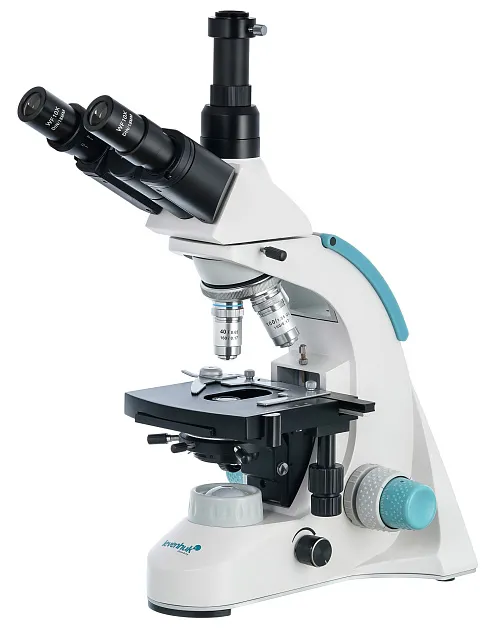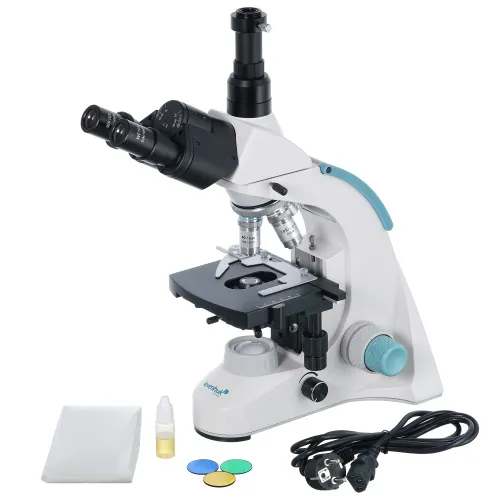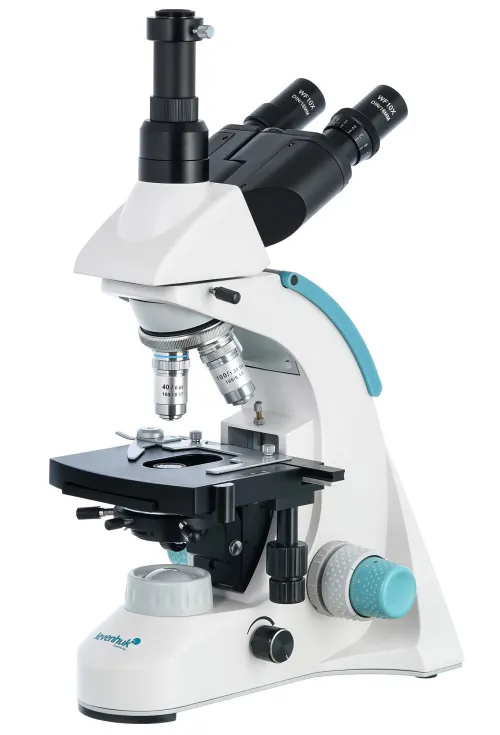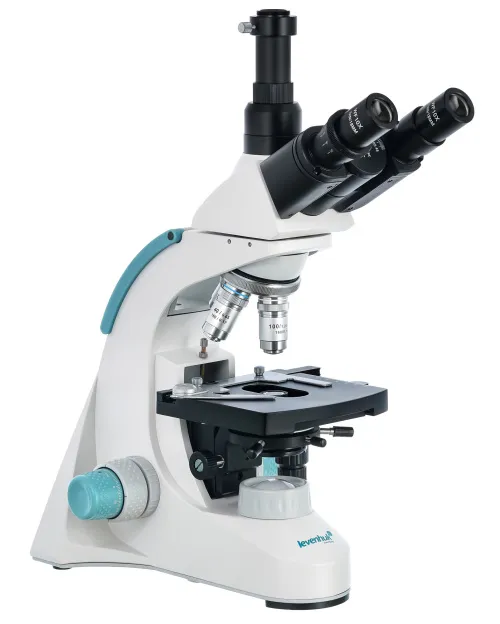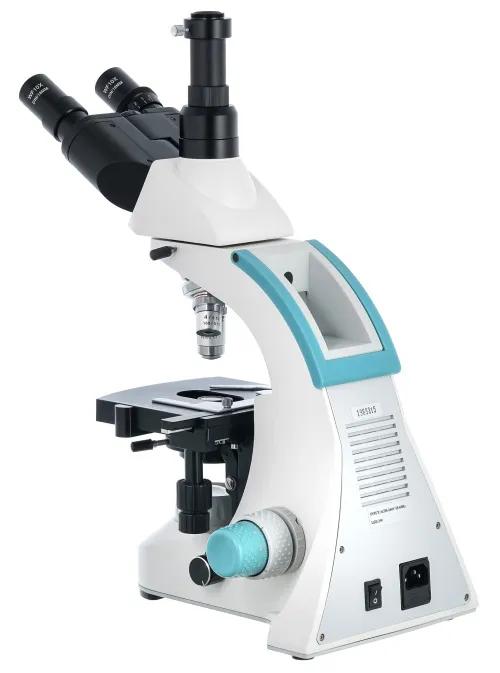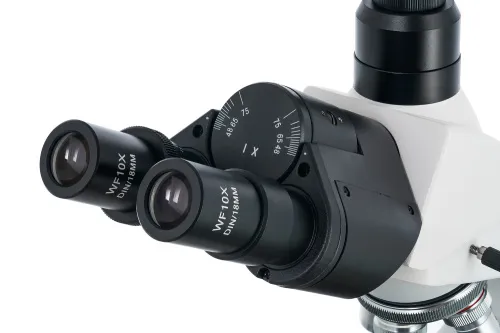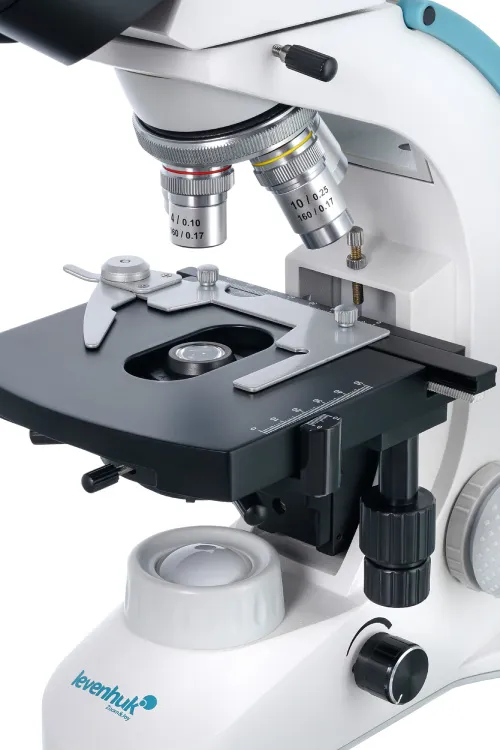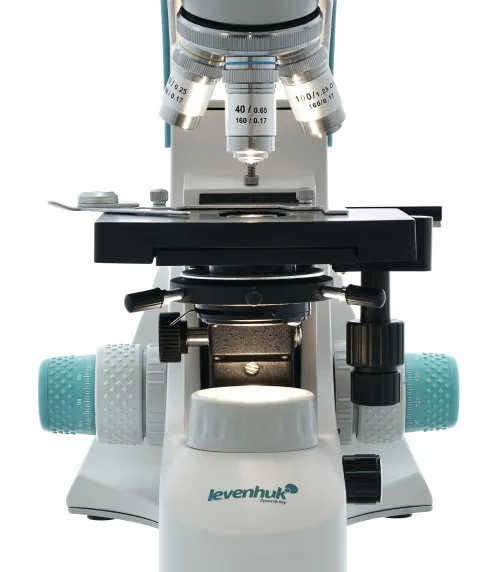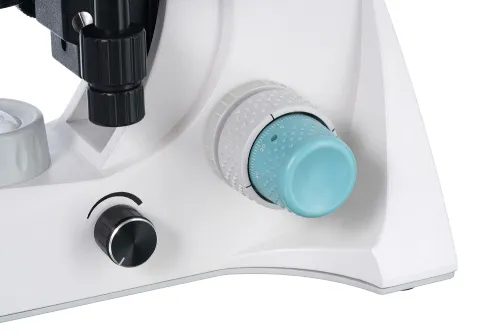Levenhuk 900T Trinocular Microscope
Magnification: 40–1000x. Trinocular head, achromatic objectives, LED light with a collector
| Product ID | 75430 |
| Brand | Levenhuk, Inc., USA |
| Warranty | lifetime |
| EAN | 5905555005348 |
| Package size (LxWxH) | 41x33x25 cm |
| Shipping Weight | 6.56 kg |
Levenhuk 900T is a trinocular model, which allows for installing a digital camera. The microscope performs great in laboratory research and can be used for educational purposes. All observations are conducted in a bright field in incident light; oil immersion is available as well. The microscope can be used for general clinical, histological, cytological, bacteriological, and other microbiological research.
The microscope head consists of a binocular part for visual observations and a vertical tube for a video eyepiece. This allows you to simultaneously study the sample and record observations to the camera (the camera is purchased separately). The head can be rotated 360°, which is convenient for group work. The wide-field achromatic optics provide magnification from 40x to 1000x. The kit includes 10x eyepieces and 4x, 10x, 40x, and 100x objectives. The 40x and 100x objectives are equipped with spring-loaded frames. There is fine and coarse focusing adjustment.
The microscope stage is equipped with a mechanical scale. Under the stage, there is an Abbe condenser with an iris diaphragm and a filter holder. Powerful LED lighting is supplemented by a collector, the brightness of the lighting is adjustable. AC power is used for the power supply.
Features:
- Trinocular head with 360° rotation
- Achromatic objectives, wide-field eyepieces, magnification from 40x to 1000x
- 3W lower LED lighting
- Brightness adjustment; AC power supply
- Metal body, standard eyepiece barrel diameter
The kit includes:
- Microscope
- 4x, 10x, 40xs, 100xs (oil) achromatic objectives
- WF10x/18mm eyepieces (2 pcs)
- Abbe condenser N.A. 1.25 with an iris diaphragm and a filter holder
- Filters: blue, green, yellow
- Fuse
- C-mount
- Bottle of immersion oil
- Power cord
- Dust cover
- User manual and lifetime warranty
| Product ID | 75430 |
| Brand | Levenhuk, Inc., USA |
| Warranty | lifetime |
| EAN | 5905555005348 |
| Package size (LxWxH) | 41x33x25 cm |
| Shipping Weight | 6.56 kg |
| Type | biological, light/optical |
| Microscope head type | trinocular |
| Optics material | optical glass |
| Head | 360 ° rotatable |
| Head inclination angle | 30 ° |
| Magnification, x | 40 — 1000 |
| Eyepiece tube diameter, mm | 23.2 |
| Eyepieces | WF10x/18mm (2 pcs.) |
| Objectives | achromatic: 4x, 10x, 40xs, 100xs (oil immersion) |
| Revolving nosepiece | for 4 objectives |
| Interpupillary distance, mm | 48 — 75 |
| Stage, mm | 130x120 |
| Stage moving range, mm | 70/30 |
| Stage features | mechanical double-layer |
| Eyepiece diopter adjustment, diopters | ±5 |
| Condenser | Abbe N.A. 1.25 with an iris diaphragm and filter holder |
| Diaphragm | iris |
| Focus | coaxial, coarse (25mm) and fine (0.002mm) |
| Body | metal |
| Illumination | LED |
| Brightness adjustment | ✓ |
| Power supply | 110–220V |
| Light source type | with a collector, 3W LED |
| Light filters | blue, green, yellow |
| User level | experienced users |
| Assembly and installation difficulty level | easy |
| Application | laboratory/medical |
| Illumination location | lower |
| Research method | bright field |
| Pouch/case/bag in set | dust cover |
We have gathered answers to the most frequently asked questions to help you sort things out
Find out why studying eyes under a microscope is entertaining; how insects’ and arachnids’ eyes differ and what the best way is to observe such an interesting specimen
Read this review to learn how to observe human hair, what different hair looks like under a microscope and what magnification is required for observations
Learn what a numerical aperture is and how to choose a suitable objective lens for your microscope here
Learn what a spider looks like under microscope, when the best time is to take photos of it, how to study it properly at magnification and more interesting facts about observing insects and arachnids
This review for beginner explorers of the micro world introduces you to the optical, illuminating and mechanical parts of a microscope and their functions
Short article about Paramecium caudatum - a microorganism that is interesting to observe through any microscope

